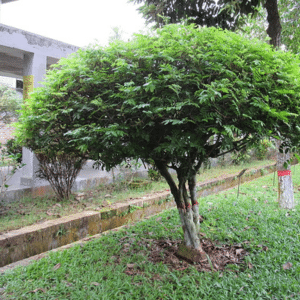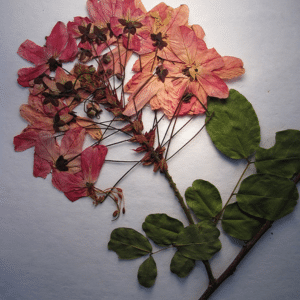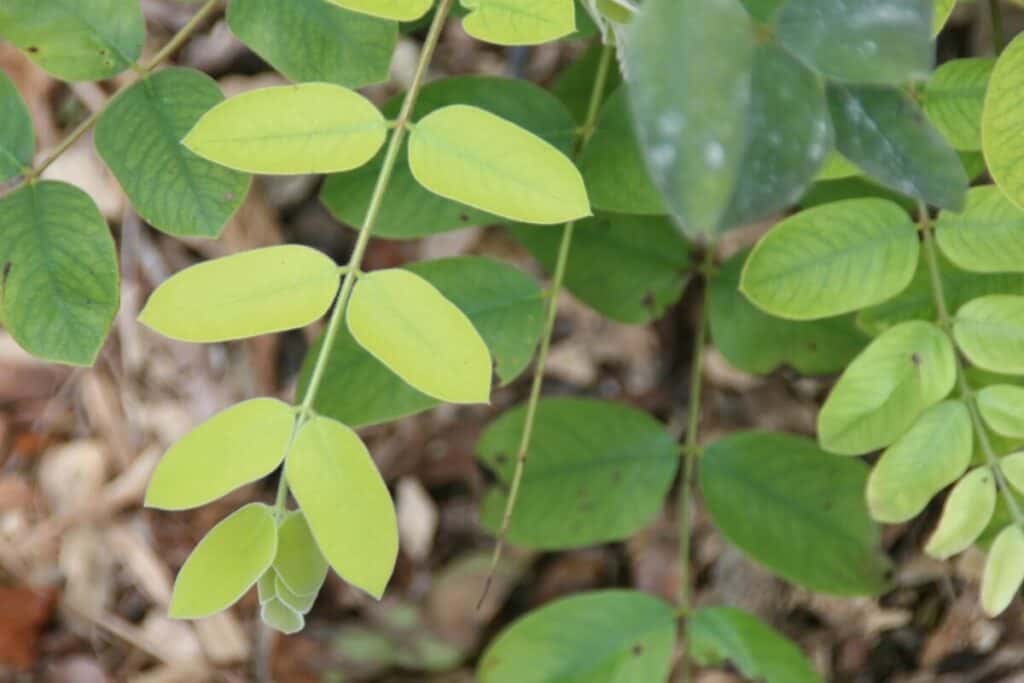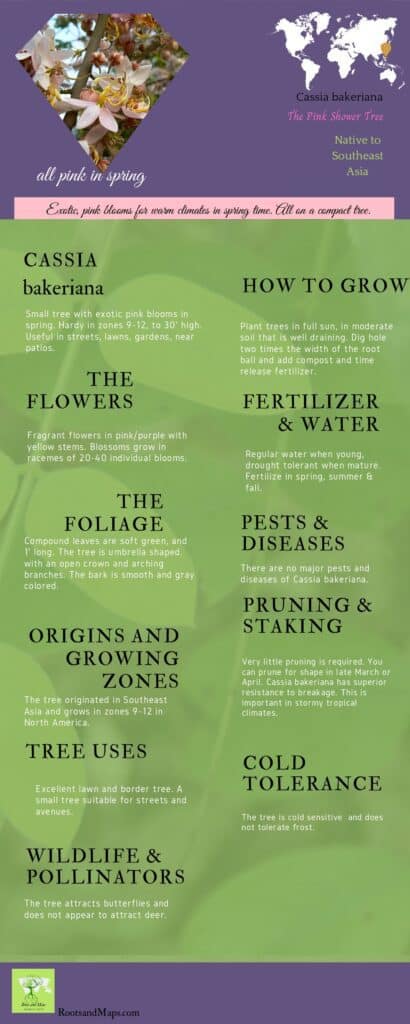Cassia bakeriana
A lot of experts think that this small beauty has a great future in warm parts of the US. We have only a few of these beautiful trees and those for only the last 15 years. Of south Asian origins, its salient features are its extremely beautiful pink flowers and compact size. It has potential for use on streets, patios, and small backyards in its territory, hardiness zone 9b and warmer.
How To Read The Names Of Your Tree
Plants tend to have two names. There is a common name, like Pink Shower Tree. These are the names popularly used but because they are personal and regional, can be confusing.
The Popular Name
So for example we have a cute name for the “powder puff plant.” The problem is that there are three plants growing in our region with the same name! It gets worse, one is a ground cover, one is a shrub and the last is a tree! You wouldn’t just want to call the nursery and order a dozen Powder Puffs!
The Botanical Name
Then the plant has its botanical name which is universally used; throughout the world. This name covers its Genus and its species. So we call the tree Cassia bakeriana. If the name is in italics (or underlined if handwritten) the first word is the Genus and it is capitalized and the second name is the species and is not capitalized. In cases in which there is a special variety it follows the species name and is italicized. But if the variety is man-made it is a cultivar and is never italicized. So that’s how you know exactly what you are buying!
If you would like a little more information on Binomenal Nomenclature or Latin for Gardeners read this.
What The Pink Shower Tree Can Do For Us
The Pink Shower Tree-Shape And Size

Cassia bakeriana, the “pink shower tree” brings a great opportunity and solves some problems we could not fix before. With its ethereal pink blossoms, undemanding nature and long bloom season people in our warm regions are comparing it to cherry trees. It seems to be a plant that people become attached to. I find it interesting how often it is our emotional attachment to a plant that makes it successful. This is the Cassia javinica.
Courtesy of Wikimedia Commons Images Afifa Afrin, CC BY-SA 3.0 https://creativecommons.org/licenses/by-sa/3.0, via Wikimedia
Expect the Cassia bakeriana to reach a height of 30′. It has strong arching branches and an open spreading crown consisting of feathery compound leaves. The overall shape and appearance of the tree is umbrella-like and the bark is smooth and gray.
Pink Showers Of Blossoms

The fragrant flowers, in pink/purple, have yellow stamens. (Note them in the image above.) They grow in racemes 4″-10″long. Full and rich with color, each raceme holds 20-40 flowers! Also notice how the three-inch flowers wrap around and enclose the twigs. The flowers fade to pale pink and almost white, enhancing the connection to cherry trees. When not in bloom the foliage is graceful and, attractive, important for year-round appearance.

What’s a Raceme? It is a cluster of flowers in which each separate flower is attached by short stalks located at equal distance along the central stem. You will see it to begin flowering from the base and moving outward.
Image courtesy of Forest & Kim Starr, CC BY 3.0 US https://creativecommons.org/licenses/by/3.0/us/deed.en, via Wikimedia Commons
Soft Green, Compound Foliage
The leaves are one foot in length, feathery, curving, and blue-green in color. An open and spreading crown has strong arching branches and the bark is smooth and gray.
Today expect to see the tree grown as an ornamental in tropical and subtropical areas of the world.

Notice, here that the leaves of the pink shower tree are large, compound, even pinnate, soft, and green. Each full leaf has 5-7 small leaflets.
The pastel green leaves are the newest growth so that the tree appears to be multi-colored green. Do you like that bi color look?
Some Benefits of the Cassia bakeriana
- Large and dramatic colored blossoms
- Long bloom season about 5-8 weeks long
- Small-medium size-20-30′ suitable as back yard trees as well as public space trees
- The Branches are flexible and resist breaking in high winds
- Does not appear susceptible to borers which affect other Cassia trees
- Low maintenance and drought tolerant when mature
- Adaptable to various soil types
How We Got The Pink Shower Tree
The tree is native to forested areas of Thailand and Myanmar, formerly Burma. It is a warm climate tree, with a northern region of zone 9b. This means that in the US it will be useful in a fairly small territory but within its territory, it looks very useful.
How Can I Use It
The Cassia bakeriana is a desirable lawn or border tree. In the community, it is used as an avenue tree, and in public spaces. From experts, I talk to, It has the potential to add substantial color and style to our communities. It will be interesting to see it grow in use.
The pink shower tree is remarkably undemanding. Before planting ensure that it has a sunny location and good drainage and you are nearly home!
Pests And Diseases
There are no major pests and diseases of this tree known to us.
How Can I Buy One?
I see the Cassia bakeriana, growing in my area, SW Florida and there are more in S Florida, in the Miami area. The dealers of young trees I find are all in the Miami area.
Note that the name Cassia bakeriana, includes the word Baker, someone’s proper name. However a species name is never capitalized even if it is there to honor someone!
Here are some dealers.
Top Tropicals
Name Confusion: The Pink Shower Tree
To call a tree with pink blooms, a “pink shower tree” is apparently irresistible! This beautiful and useful tree, the Cassia bakeriana, is most often called the pink shower tree. So are some other trees! We also use the term for the weeping pink cherry tree, which will not grow in warm climates, and is totally unlike the tropical pink blooming trees.
There are several pink blooming tropical cassia trees which are also called various common names including pink shower trees! These include the Cassia javanica, this tree should be a little shorter in height and the blooms are smaller and more rounded (it’s also called the apple blossom tree, for very little reason). There is the Cassia nodosa, with very long seed pods. The Cassia marginata, is smaller and less robust than the other trees. There is also the Cassia grandis, with stiff flower branchlets (not like the softly drooping floral display of other Cassias.)
The lesson is that each of the trees commonly called “pink shower trees” has very different features, can grow in very different environments and suits very different needs in the garden. Whichever tree you want; be very specific when placing your orders!
To get this tree, specify Cassia bakeriana.
How To Plant It
Plant and Water Your New Tree
Dig the hole twice the size of the root ball and add time-release fertilizer and organic matter. Remember to water your new tree well at planting time. How often should I water a newly planted tree? For the first few weeks after planting, water your tree daily, then, while observing the tree and environmental situation, gradually reduce the frequency to every other day, then weekly, until the tree is established, which can take 1-2 growing seasons.
Soil Requirements
The tree is adaptable to a variety of well-drained soils of a neutral pH. Like many flowering trees, it requires good drainage. How do I know if my soil drains adequately? Do this little test. (Do not assume this works for your entire garden. If other places are higher or lower, you can test again!
- Dig Yourself a Hole:
- Make it approximately 15 inches wide and deep.
- Fill It With Water:
- Fill the hole with water and note the time it takes for the water to drain.
- Watch Your Hole Drainage Speed:
- Good drainage: If the water level drops about an inch per hour, your soil drains well.
- Poor drainage: If the water takes an hour or more to drain, your soil drains poorly.
- Fast draining: If the water drains from the hole in 10 minutes or less, you have fast-draining soil.
Fertilizer For Your New Tree
First water young trees on a regular schedule when becoming established; the trees are drought tolerant as adults. Fertilize with a general-purpose product. Consider bone meal, it will help to maximize blooms.
Granular fertilizer should be applied at a rate of one large handful of most fertilizers per 1 inch of trunk diameter (measured 18″ above the soil line) for most plants. Do not over fertilize as it will do more damage than not fertilizing at all. Also note that you can apply granular fertilizer can be applied on top of mulch.
Fairchild Tropical Garden is the only truly large tropical garden in North America, Here is their advice on fertilizer for the climate.
Pruning and Staking
Very little pruning is required. You can prune for shape in late March or April. The Cassia bakeriana has superior resistance to breakage. In a tropical climate with heavy winds, this is important.
The young trees (under 5 years) will benefit from staking, particularly in windy summer weather.
Pests And Diseases
This is a very disease-resistant plant. Leaf spot and mildew may happen.
Cold!
The pink shower tree is cold-sensitive, I would be aware of this in the northern range of its territory, Also note that the foliage is deciduous and will drop in the cold.
Pollinators
We are in luck here! The flowers on the pink shower tree will attract both butterflies and bees to your garden.
Summary
If your environment could be improved with the spectacular flowers, and low maintenance attributes the pink shower tree is a contender. It may change our environment as they are recommended as an alternative to the live oak.
This link will take you to an article on flowering trees. It includes tables with the names and features of both temperate climate trees and tropical trees. In the tropical trees section, you will find companion trees for the Pink Shower Tree.
Will tropical towns start to offer a “Pink Shower Festival,” let’s see!
Happy Digging!
References

